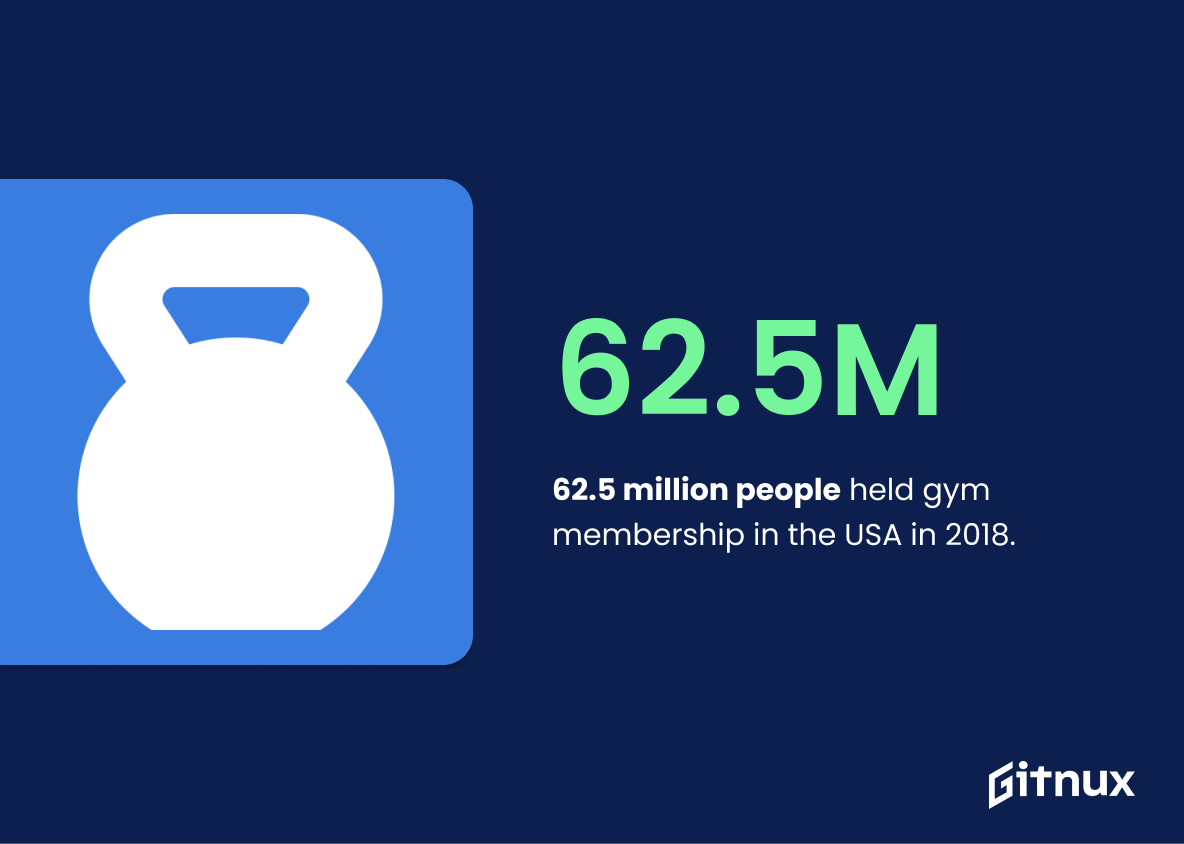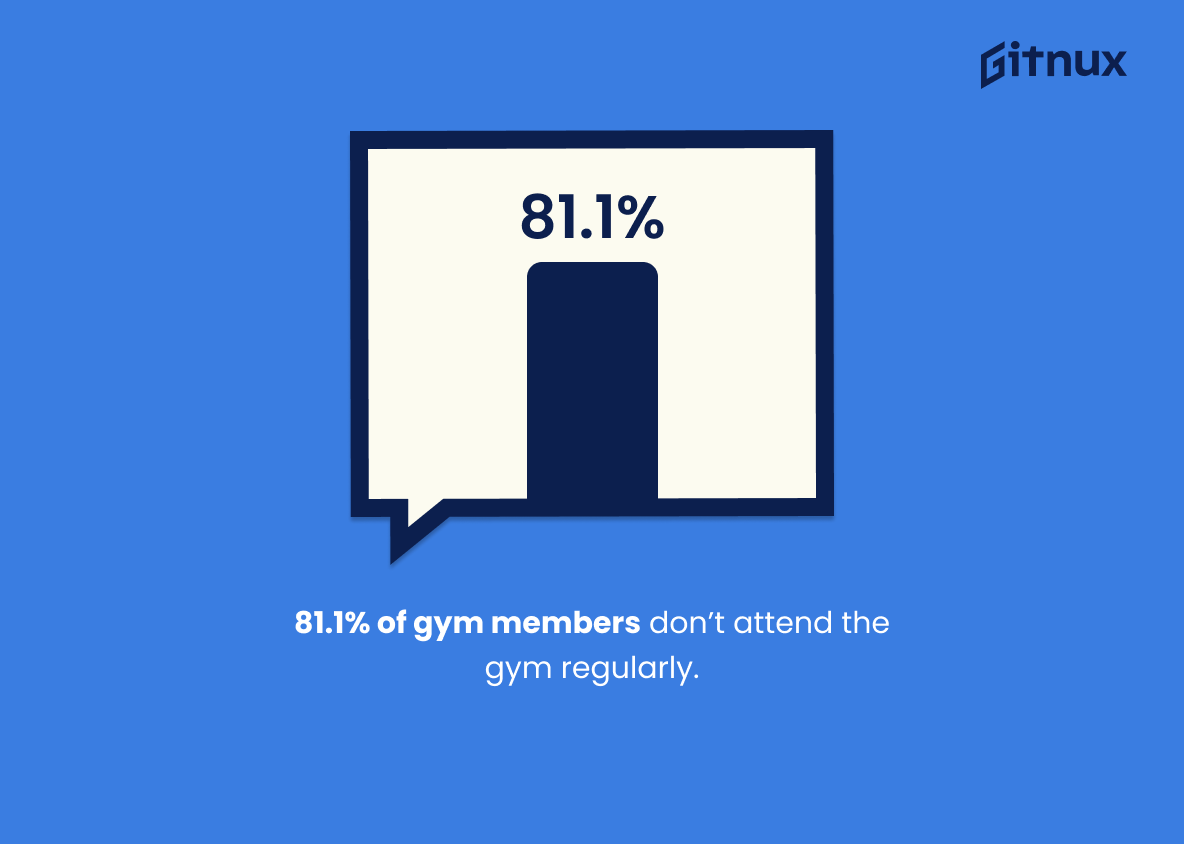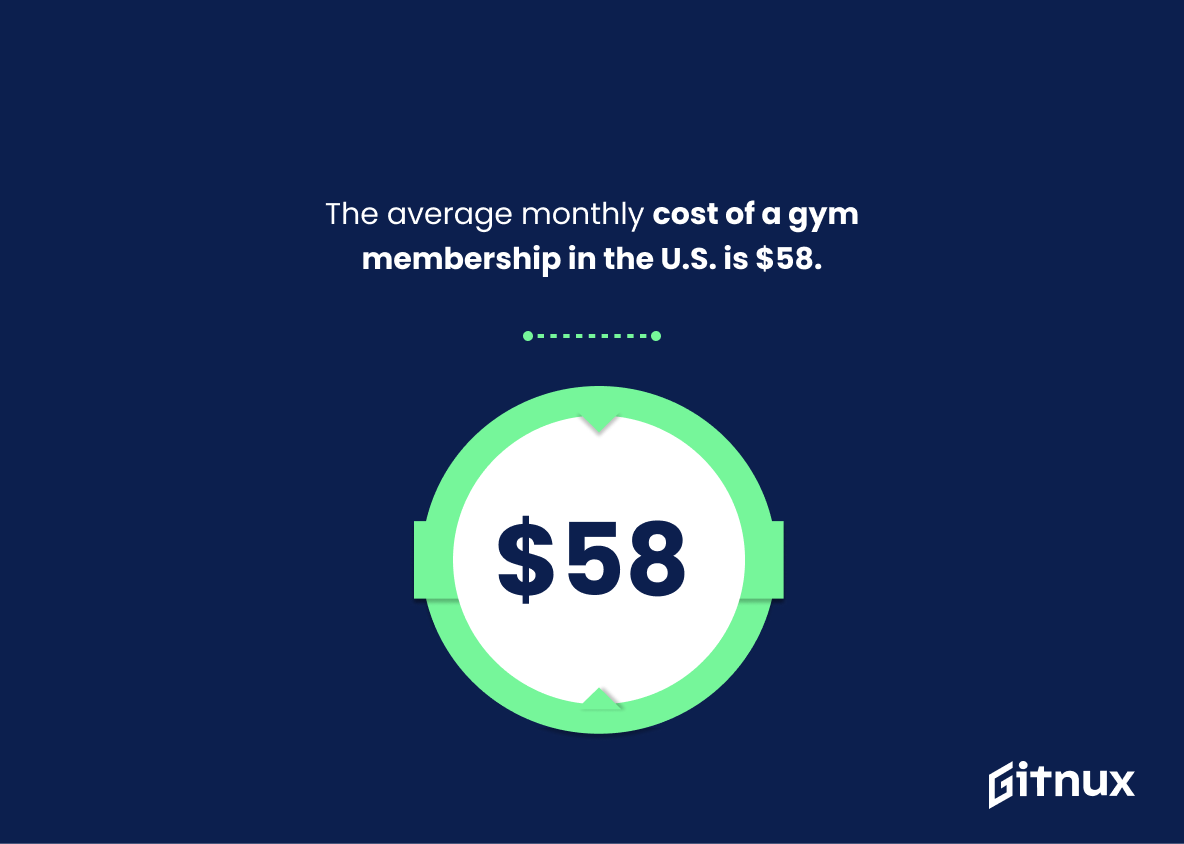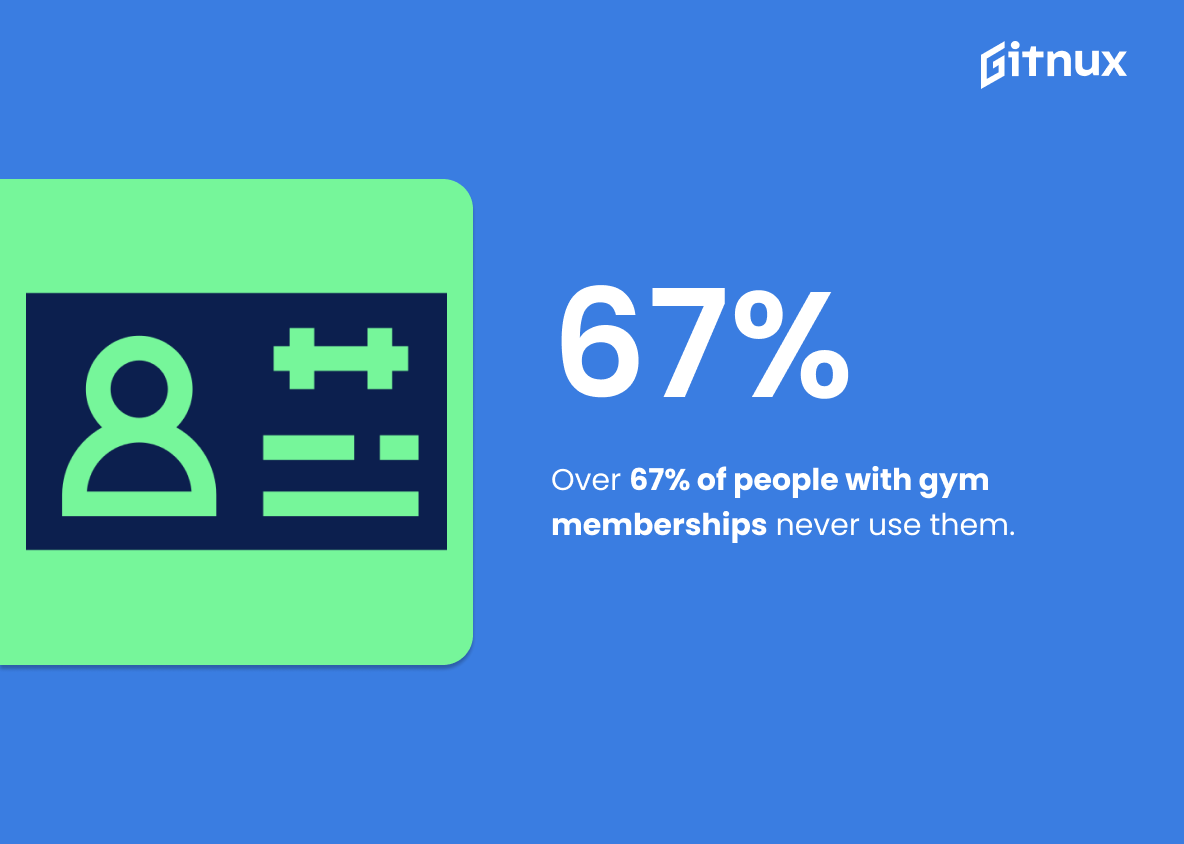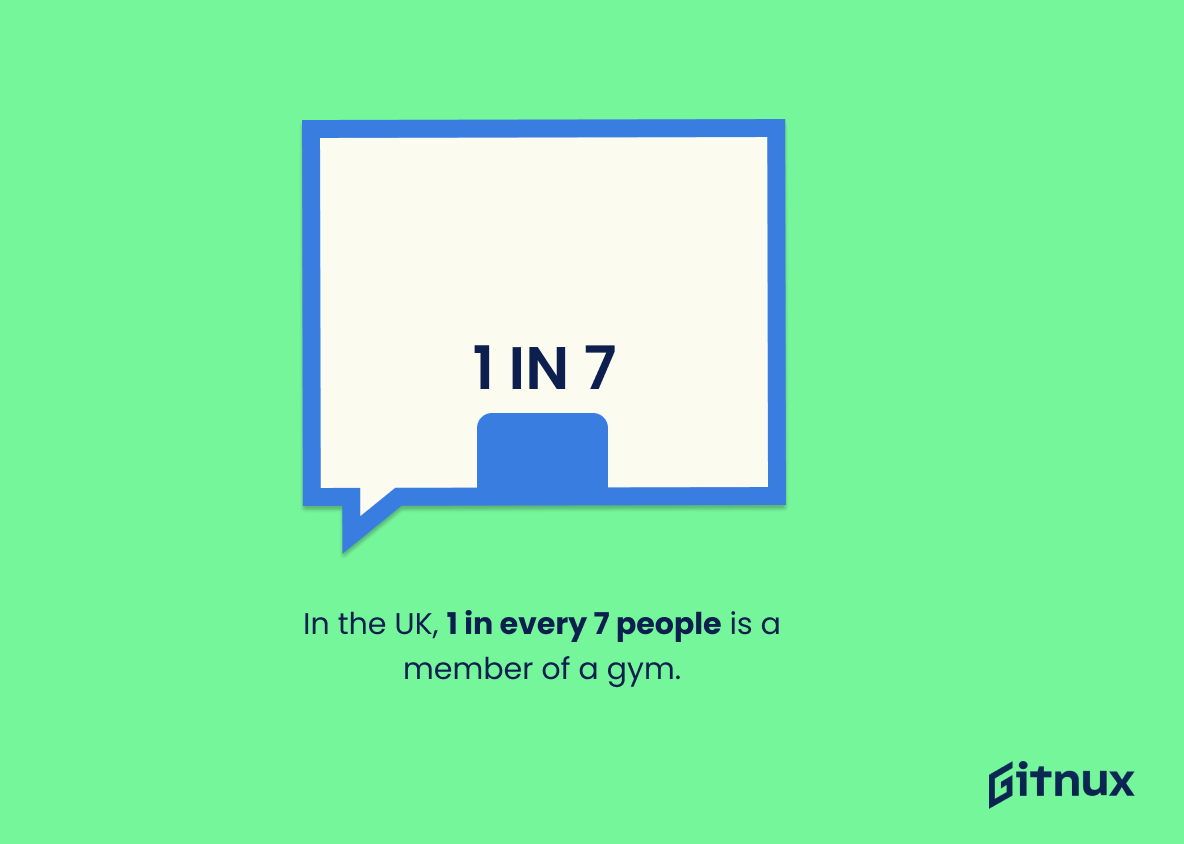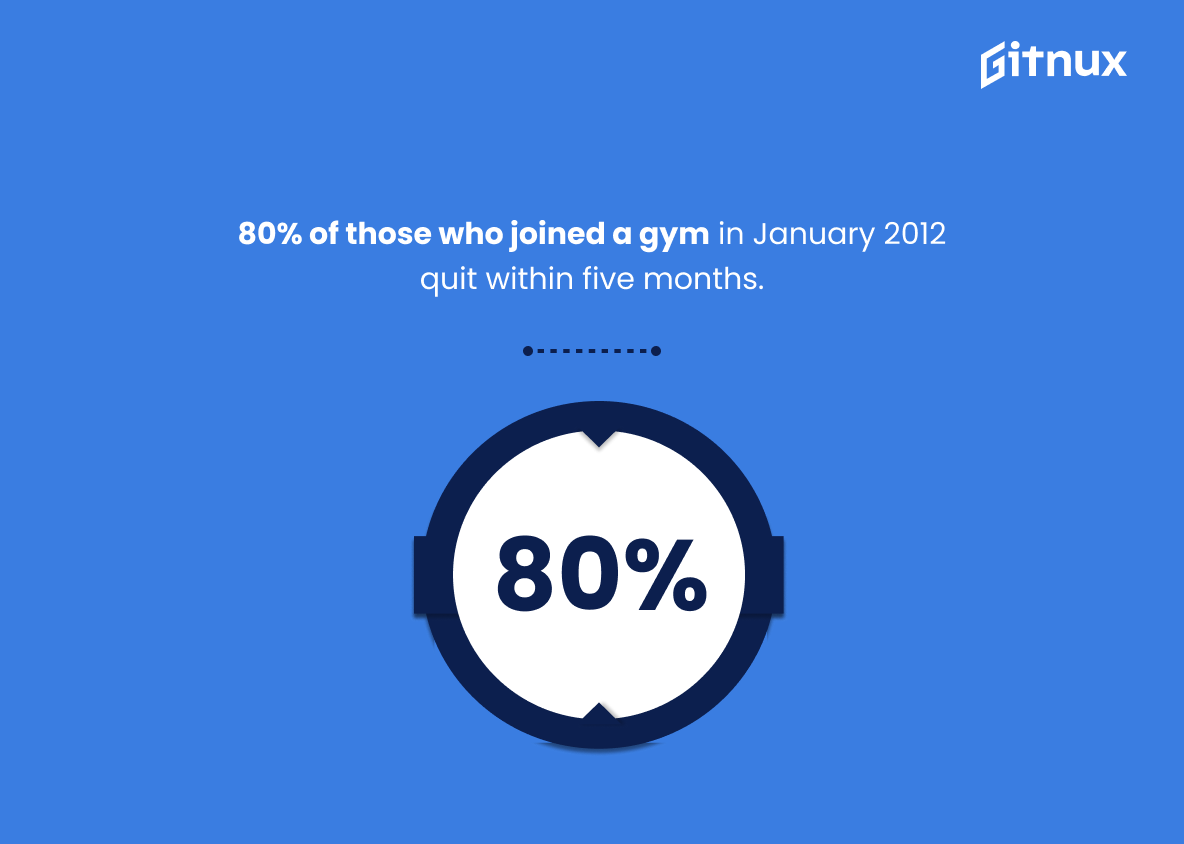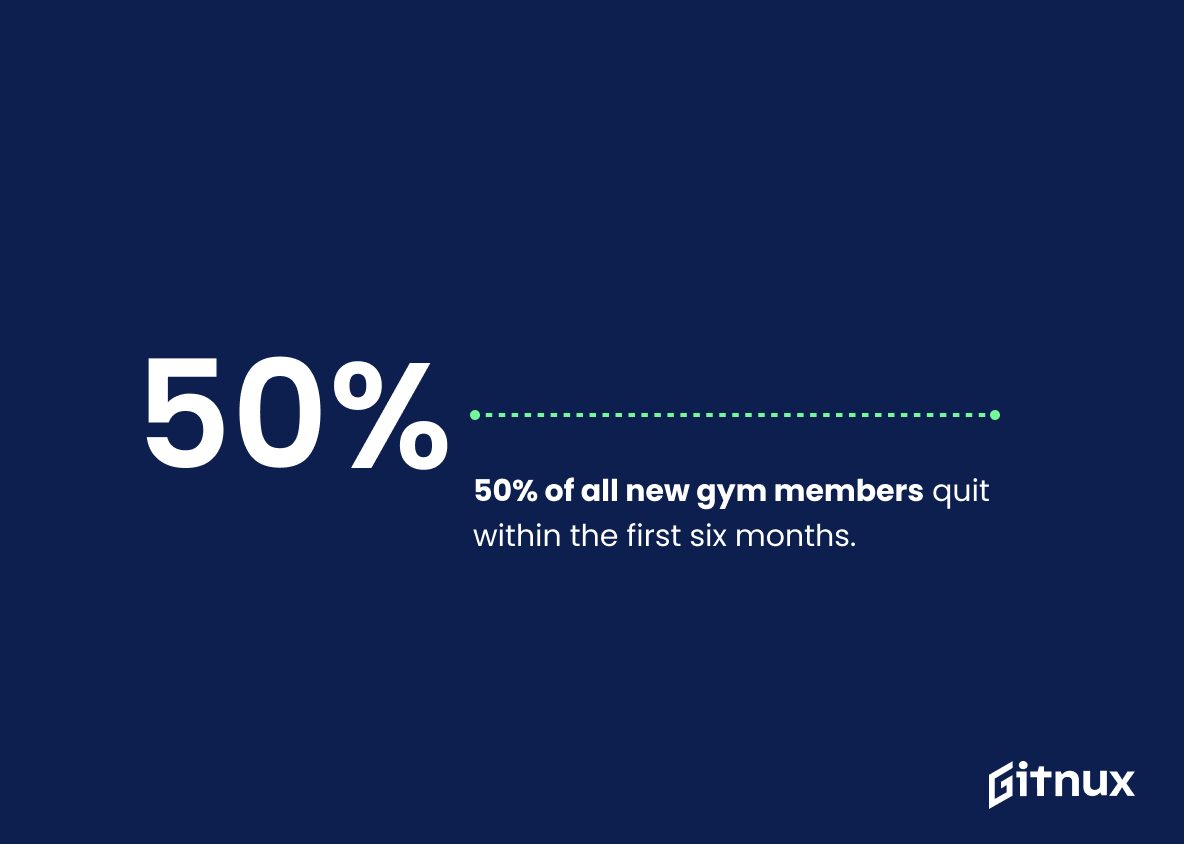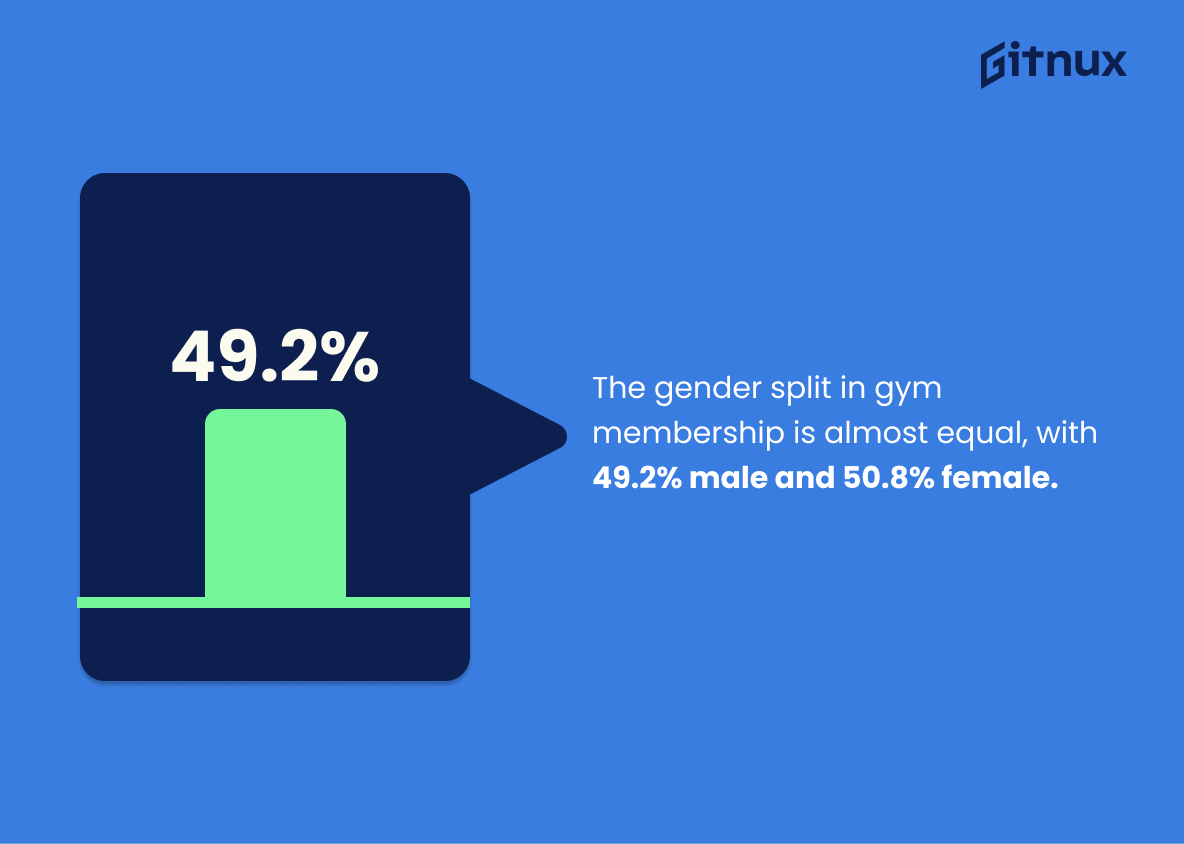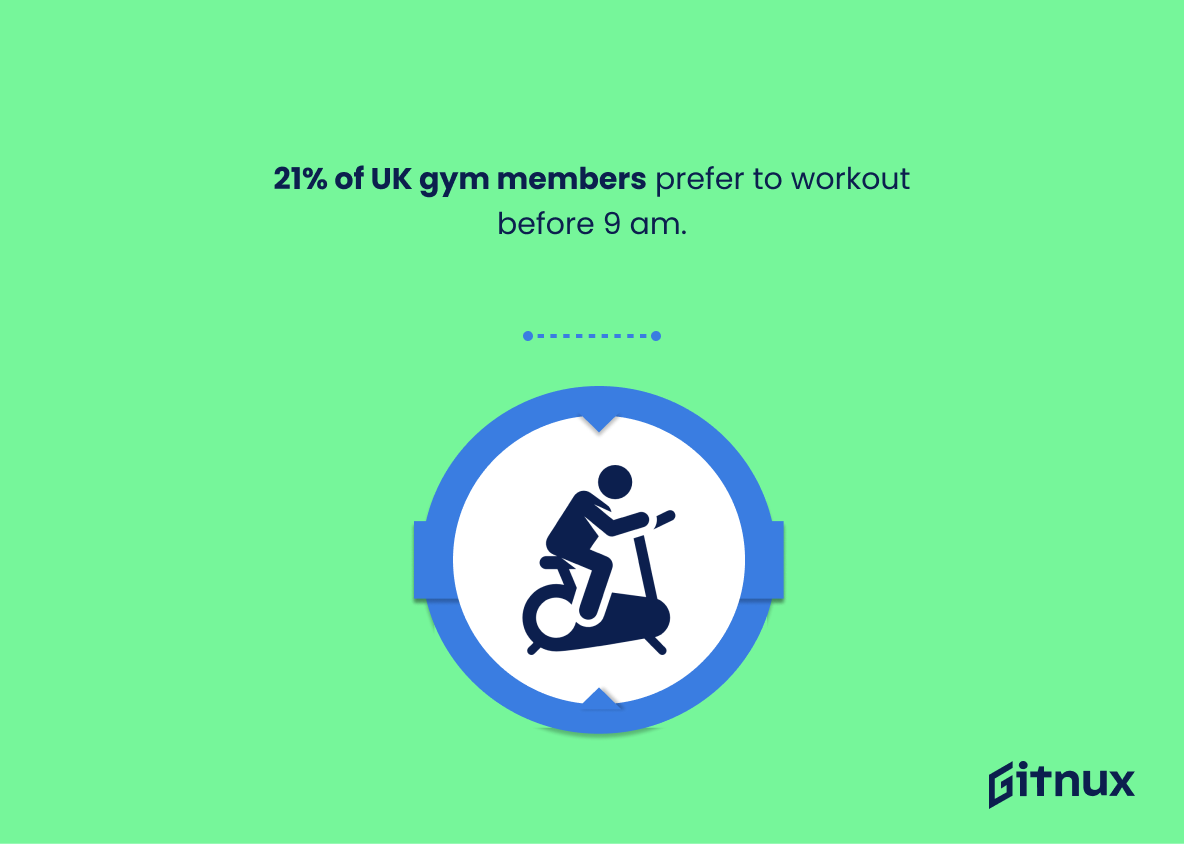In today’s health-focused society, the business of fitness centers is booming, with gym memberships becoming a pivotal part of many people’s lives. But have you ever stopped to ponder about the diverse facets of the gym industry, such as the notable statistics that revolve around gym memberships? Deciphering these numbers, trends, and data can give us an in-depth understanding of the intricate dynamics in the fitness industry.
In this blog post, we delve deep into an exploration of gym membership statistics, examining everything from average membership rates to member retention rates and everything in between. Join us as we navigate through the world of fitness from a numerical perspective, promising to offer an insightful journey.
The Latest Gym Membership Statistics Unveiled
62.5 million people held gym membership in the USA in 2018.
Highlighting the fact that a staggering 62.5 million people held gym memberships in the USA in 2018 serves as a robust indicator of the escalating trend toward health and fitness. It underscores the burgeoning popularity of gym culture and captures a strong market affinity for fitness-related activities.
This considerable figure effectively draws a vivid picture of the gym industry’s gravitational pull, thereby anchoring the entire narrative of gym membership statistics in a striking and influential context. Furthermore, it sets the tone for a detailed analysis of gym usage habits, attendance patterns, consumer preferences, and potential growth trajectories in the industry.
81.1% of gym members don’t attend the gym regularly.
Exploring the intriguing facet of gym membership statistics, one cannot ignore the essential nugget that sheds light on gym attendance – 81.1% of gym members don’t frequent their gyms consistently. This revelation strikes at the heart of gym membership dynamics in several compelling ways.
Firstly, it paints an authentic narrative about gym-going habits, going beyond surface-level enrollment numbers which often paint an overly rosy picture. Secondly, this statistic poses important questions for gym operators about member engagement and retention strategies. Are current offerings or schedule options meeting members’ needs, or is there room to innovate and improve? Thirdly, it underscores the gap between good intentions (signing up for the gym) and sustained action (regular attendance), creating an avenue to explore psychological motivations or societal trends.
Lastly, for prospective gym members reading the blog, this statistic acts as a reality check. It might prompt them to find a gym that specifically addresses adherence issues or to make additional plans to ensure they belong to the elusive 18.9% who do attend regularly, ultimately leading to better health outcomes.
The global fitness and health club market amounted to more than 96.7 billion U.S. dollars in 2019.
Elucidating the enormity of the global fitness and health club industry, which apparently stood at a striking 96.7 billion U.S. dollars value in 2019, magnifies the importance of gym membership statistics. Such vast market size indicates the considerable potential of health clubs in influencing public health trends, hence highlighting gym membership statistics as significant insights.
They enable us to discern patterns, track growth, and comprehend member behavior and preferences. This considerable dollar figure isn’t just a testament to the industry’s boom, but an invitation to delve deeper into gym membership metrics to unravel factors contributing to such growth and profitability.
In 2019, there were approximately 6,100 U.S. health clubs, and gym memberships totaled 64.19 million.
Delving into the importance of these figures, we’d understand that the landscape of the U.S. fitness industry is incredibly vast, marked by an impressive number of health clubs (6,100) dominating the scene in 2019. This paints a vibrant portrait of a well-engrained culture of fitness and health-consciousness, testifying to the profound reach and influence of these establishments.
Furthermore, the whopping count of 64.19 million gym memberships hints at the profound impact of these fitness centers in shaping lifestyles and health choices of American citizens. It serves as a testament to the fact that a significant portion of the population considers fitness as a key pillar of their lives, underlining the thriving market potential for gym and fitness enterprises.
These figures, essentially, mirror the pulse of the fitness industry and are instrumental in predicting future trends, thereby informing key marketing and business strategies for gym owners, fitness coaches, and related businesses.
The average monthly cost of a gym membership in the U.S. is $58.
Delving into the captivating world of gym membership statistics, the figure of $58 stands out as the average monthly cost across the U.S. It serves as a pivotal benchmark, setting the landscape for gym-goers’ financial commitment nationwide. A close inspection of this number unlocks insights about overall consumer behavior, affordability trends, and spending patterns in the health and fitness industry.
In the grander scheme, it aids in drawing comparisons across regions, income groups, or even different fitness options. Thus, the $58 mark not only anchors our understanding of today’s gym economics but also helps to ignite conversations about future trends and the value of investing in personal fitness.
Over 67% of people with gym memberships never use them.
Unraveling the enigma of gym memberships, a striking fact emerges: a whopping 67% of individuals armed with gym subscriptions seem to shy away from actually stepping into these fitness hubs. This fascinating number weaves a narrative much like a modern-day allegory, shedding light on a profound disconnect between people’s intentions and their actions. It’s a tale that’s as much about ambition and aspiration, as it is about lack of motivation, time or possibly, fading resolve. It’s a fitness paradox we can’t afford to ignore.
It’s a wake-up call for gyms to rethink their strategies, perhaps by personalizing experiences or offering flexible memberships, and an alarm bell for those paying for unused gym access. So, as we dig deeper into the world of gym membership statistics, this is the 67% conundrum that will guide our journey.
In the UK, 1 in every 7 people is a member of a gym.
Diving into the world of gym membership statistics, the UK presents a rather intriguing narrative. With 1 in every 7 people in the UK being a gym member, imagine a weekly gathering of seven friends, relatives or colleagues. Among these seven, one individual can be predicted to be gym-engaged. This statistic acts as a spotlight, illuminating the significance of fitness and health consciousness that prevails across the UK population. It helps to pinpoint the potential market size for fitness businesses while also offering insights into public health trends.
This fitness footprint also fosters connections with other relevant topics, like monthly gym membership spend, diverse gym offerings, community health initiatives, and even the digital fitness surge. So, when we delve deeper into the realm of gym membership statistics, the ‘1 in 7’ figure stands as a powerful starting point, a number that tells a compelling story about the UK’s collective pursuit of health and well-being.
January is the most popular month to start a gym membership.
Unveiling the curtain of gym membership trends, it becomes fascinatingly clear that January emerges as the champion of membership initiations. The significance of this statistical gem goes beyond the mere numbers. From the lens of a new year’s resolution perspective, this surge reflects the determination of individuals launching their fitness journeys, driven by the wave of “New Year, New Me” aspirations.
Furthermore, this statistic provides an insightful navigation marker for gym owners and marketers. It crafts an opportunity to tailor marketing strategies, discounts, and recruitment drives specifically for the first month of the year, capitalizing on the footfall driven by the desire for transformation. Hence, this January spike is more than just a number, it’s a phenomenon that bears upon the strategic, philosophical, and psychological aspects of our gym-going culture.
Approximately 36% of regular exercisers participate in a fitness class of some kind.
Delving into the realm of gym membership statistics, one can’t overlook the intriguing fact that roughly 36% of regular exercisers are actively engaged in some form of fitness class. This statistic not only illuminates the preferences and practices of gym goers, but also provides vital insight into the functional anatomy of a flourishing fitness industry.
With such a substantial percentage of regular sports enthusiasts opting for fitness classes, it emphasizes the importance gyms need to place on offering a diverse and appealing array of classes. For gyms, this could mean the difference between maintaining a thriving community of satisfied members and struggling with member retention.
In terms of the wider fitness landscape, this statistic serves as a testament to the significance of group workout dynamics in sustaining motivation and fostering a sense of camaraderie amongst gym-goers, thereby enhancing overall member experience.
To put it simply – this percentage is more than just a number. It’s a narrative of how people prefer to workout and what they expect from their gym memberships, whispering advice in the ears of the gym owners about what might just keep their enterprise fit as a fiddle.
80% of those who joined a gym in January 2012 quit within five months.
Painting a candid picture of gym commitment, the nugget that 80% of individuals who jumped on the fitness bandwagon in January 2012 waved the white flag within five months offers critical insight. This statistic stands as a crucial paragraph in the ever-unfolding story of gym membership dynamics. It highlights the stark reality of high attrition rates post New Year resolution high and illustrates the struggle most people face in sticking with fitness routines.
As such, it becomes a defining parameter when evaluating member retention strategies and tailoring new fitness programs. Moreover, for prospective gym-goers and fitness enthusiasts, this number provides a realistic outlook on the perseverance required for maintaining a gym membership.
Australians spend $1.4 billion on unused gym memberships each year.
Peeling back the curtain on gym membership trends reveals a startling reality that Australians funnel a staggering $1.4 billion annually into dormant gym memberships. This thundering revelation underscores a potential disconnect between fitness aspirations and actual usage patterns, serving as both a warning and a call to action for consumers and gym owners alike.
For consumers, it’s a wake-up call urging them to reevaluate their investment and use their memberships more optimally, whereas for gym operators, it underscores the urgency to innovate and create experiences that keep members excited, active and engaged. Casting a stark light on this fiscal elephant in the room, we are nudged into reconsidering how health and fitness industries can turn this trend around and unleash the true potential of a conscious and impactful fitness journey for Australians.
44% of gym-goers exercise 1-3 times per week.
Delving into the world of gym membership statistics, it’s intriguing to discover that nearly half of gym enthusiasts, to be precise 44%, hit the gym 1-3 times a week. This insight provides astounding perspective to both gym owners and potential members alike. For entrepreneurs, understanding the frequency of member visits could assist in scheduling classes, peak time management, or deciding upon membership packages to better cater to the needs of this prominent user group.
Meanwhile, for those contemplating a gym membership, this statistic offers a re-assuring nod that many fellow members also balance their fitness pursuits amidst a busy life, making the gym a feasible commitment rather than an unrealistic expectation. Undoubtedly, this numeric revelation casts a vital light in the vast landscape of gym membership narratives.
50% of all new gym members quit within the first six months.
Unveiling the harsh truth that half of all new gym recruits abandon ship within their initial six months invites an intriguing exploration into gym membership dynamics. This figure doesn’t simply provide a stark revelation; instead, it acts as a launchpad for diving into intricate reasons behind the daunting dropout rate.
It probes into areas like member’s motivation levels, effectiveness of gym programs, attributes of customer service, or perhaps the overall ambiance of gym facilities. Furthermore, this eye-opening fact also sparks a compelling discussion about crafting strategies to increase retention rates and improving member’s commitment to fitness goals.
The gender split in gym membership is almost equal, with 49.2% male and 50.8% female.
In the intricate dance of data interpretation, a balanced gender split in gym membership – 49.2% male and 50.8% female – emerges from the shadows to take center stage, spotlighting an underlying narrative of gender equality in health pursuits. This statistic intensifies the drama; under its revealing light, we see that the gym culture, typically imagined to be testosterone-driven, is in fact, a playground where both genders engage in the pursuit of fitness and health at almost equal capacities.
Entwined in this narrative is a potent signal of changing societal values, where the quest for fitness and wellness is no longer confined to a specific gender, but has become a shared ambition. This statistical revelation transforms our understanding of the gym space, painting it in richer, more inclusive tones, inviting deeper reflection on the dynamics at play in gym membership trends.
21% of UK gym members prefer to workout before 9 am.
Unraveling the gym membership statistics in the UK, an enlightening insight emerges – a notable 21% of the fitness community are eager to kick-start their day with an early morning workout, all before the clock strikes 9 am. This intriguing revelation not only sheds light on the exercise preferences of gym-goers but also sketches an image of the “Dawn Warriors”, those who choose fitness over the comfort of the bed.
This knowledge could be highly impactful for gym owners and fitness trainers in scheduling their sessions or tailoring their facilities to cater to this early bird bunch. Furthermore, understanding this pattern may inspire other members to reconsider their workout timings, potentially leading to more balanced usage of gym resources throughout the day.
14.3% of current gym goers think using equipment is the most intimidating factor.
Understanding gym-goer’s perceptions can significantly influence how gym and fitness centers strategize their member engagement and retention plans. Looking into this, it is quite riveting to note that a 14.3% fraction of gym enthusiasts consider the use of equipment as quite daunting. This plays a critical role, serving as a barometer for areas that gym owners or wellness organizations need to pivot their attention towards.
This percentage signifies an opportunity for these establishments to provide detailed equipment instruction sessions or personalized instructor-led demonstrations. Therefore, in a blog post about gym membership statistics, highlighting this factor adds value by suggesting room for an enhanced gym experience that may lead to increased membership satisfaction and retention.
35% of gym members use personal training services.
Unraveling the intricate patterns of gym membership trends, we stumble upon an intriguing facet. The fact that 35% of gym members utilize personal training services is not just a random digit floating in a sea of statistics. Rather, it serves as a critical beacon for gym owners, potential investors, and fitness enthusiasts alike exploring this terrain.
Experiencing the gym through the lens of a personal trainer vastly changes the topography. For the owners, this implies a significant portion of their members appreciate and demand a more tailored fitness journey. This could potentially trigger strategic changes in service offerings and resource allocation to meet this demand.
On the other hand, this nugget of information can be an arterial road for potential gym-goers. Those who enjoy a more structured, personal touch to their regime, can glean from this data a gym’s commitment or lack thereof, to personal training. It acts as a vital thermostat in regulating their gym selection process.
Lastly, for prospective investors or those interested in understanding the fitness industry, this tiny statistic paints a broader picture of customer behavior and market trends. It points to the existence of a significant consumer segment that values personalized service and could open pathways to specific investment opportunities.
So, a peek into the 35% usage rate of personal training services brings us way beyond the number. It’s not just a figure; It’s a frame within which countless gym-related decisions are articulated, aiding us in decoding the complex narrative of Gym Membership Statistics.
Conclusion
In summary, gym membership statistics provide valuable insight into the ever-evolving fitness industry. They shed light on consumer behaviors, trends, and preferences, playing a crucial role in influencing strategic decisions of gym owners, fitness enthusiasts, and investors alike. Indeed, as health and fitness become even more embedded in our societal norms, the dynamics of these statistics are bound to shift, revealing new patterns and insights.
Nonetheless, one thing remains clear: the demand for gyms is not just a passing fad; rather, it reflects a growing societal emphasis on health, well-being, and active lifestyles. For anyone seeking to navigate this thriving market, staying updated on gym membership statistics promises to be an invaluable strategy.
References
0. – https://www.femalefitnesssystems.com
1. – https://www.www.ncbi.nlm.nih.gov
2. – https://www.www.news.com.au
3. – https://www.www.leisureopportunities.co.uk
4. – https://www.www.statista.com
5. – https://www.www.creditdonkey.com
6. – https://www.www.ncsf.org
7. – https://www.www.precor.com
8. – https://www.blog.gyminsight.com
9. – https://www.www.puregym.com
10. – https://www.runrepeat.com
